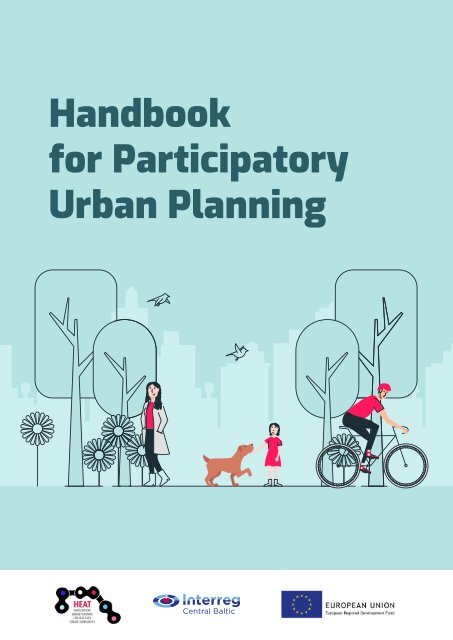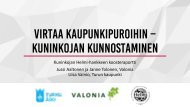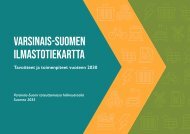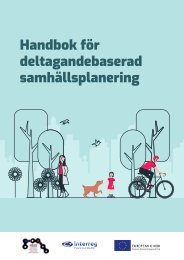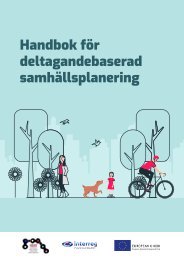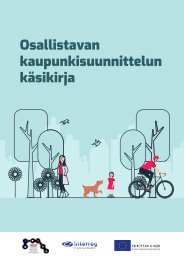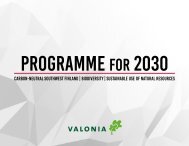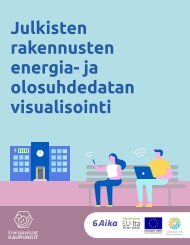Handbook for Participatory Urban Planning
This handbook is a result of an EU-funded project “HEAT - participatory urban planning for healthier urban communities”. For the last two years, the project partners from Finland, Estonia, Latvia and Sweden have worked with more inclusive and participatory processes with a focus on sustainable and healthy communities, particularly related to cycling. Nevertheless, the same principle charts the course, more or less, in any participatory process: you have a goal, and you are trying to find the best available paths to reach it. As the topic is not simple and the change is not happening overnight, we wanted to share our experiences and the knowledge gained during the project with the hope to help or inspire others trying to tackle similar issues.
This handbook is a result of an EU-funded project “HEAT - participatory urban planning for healthier urban communities”. For the last two years, the project partners from Finland, Estonia, Latvia and Sweden have worked with more inclusive and participatory processes with a focus on sustainable and healthy communities, particularly related to cycling. Nevertheless, the same principle charts the course, more or less, in any participatory process: you have a goal, and you are trying to find the best available paths to reach it. As the topic is not simple and the change is not happening overnight, we wanted to share our experiences and the knowledge gained during the project with the hope to help or inspire others trying to tackle similar issues.
Create successful ePaper yourself
Turn your PDF publications into a flip-book with our unique Google optimized e-Paper software.
<strong>Handbook</strong><br />
<strong>for</strong> <strong>Participatory</strong><br />
<strong>Urban</strong> <strong>Planning</strong>
Content<br />
Introduction & content<br />
Do your background work - build on facts and scenarios<br />
Reaching out to different audiences - facts, scenarios and<br />
presenting them effectively<br />
Investing in walking and cycling pays off <strong>for</strong> cities & citizens<br />
Data visualisation as a way of getting your point across<br />
Case: Visualizing scenarios <strong>for</strong> accessibility<br />
Case: Calculating scenarios with the HEAT<br />
How much is increased walking and cycling worth to municipalities?<br />
The importance of including stakeholders – and how to know who they are?<br />
Including different stakeholders in planning workshops and<br />
discussions has several objectives<br />
Stakeholder mapping - a tool to identify key stakeholders<br />
Interaction<br />
Plan your actions carefully<br />
How to communicate effectively?<br />
How to make the most out of an interactive workshop - online and<br />
offline<br />
Case: Valonia & Mentimeter<br />
Case: Tartu & Kahoot<br />
Engaging your stakeholders online<br />
Case: The Cycling City of Stockholm 2030 & Maptionnaire<br />
The end of the workshop is not the end of the process<br />
Case: Tartu & ArcGIS<br />
Case: Cykelfrämjandet & Google Forms<br />
5 Tips & Tricks <strong>for</strong> Interactive Digital Events<br />
Campaigns<br />
Campaigns as a tool <strong>for</strong> change<br />
How to plan a successful campaign<br />
6 questions to ask when planning a campaign<br />
Case: Valonia’s campaign promoted cargo biking<br />
<strong>for</strong> families<br />
Case: Winter bike to work day in Stockholm<br />
The principles of a successful participatory process<br />
1<br />
3<br />
5<br />
7<br />
8<br />
9<br />
11<br />
13<br />
15<br />
17<br />
19<br />
21<br />
23<br />
24<br />
25<br />
27<br />
28<br />
29<br />
31<br />
33<br />
34<br />
35<br />
36<br />
37<br />
39<br />
40<br />
42<br />
43<br />
45<br />
47
Introduction<br />
& content<br />
This handbook is a result of an<br />
EU-funded project “HEAT - participatory<br />
urban planning <strong>for</strong> healthier<br />
urban communities”. For the<br />
last two years, the project partners from<br />
Finland, Estonia, Latvia and Sweden have<br />
worked with more inclusive and participatory<br />
processes with a focus on sustainable<br />
and healthy communities, particularly<br />
related to cycling. Nevertheless, the same<br />
principle charts the course, more or less,<br />
in any participatory process: you have a<br />
goal, and you are trying to find the best<br />
available paths to reach it.<br />
As the topic is not simple and the<br />
change is not happening overnight, we<br />
wanted to share our experiences and the<br />
knowledge gained during the project with<br />
the hope to help or inspire others trying<br />
to tackle similar issues. Whether you are<br />
a municipal official, NGO staff member or<br />
an active citizen looking <strong>for</strong> tools to enhance<br />
your participatory processes, this<br />
handbook is <strong>for</strong> you.<br />
The handbook describes four<br />
essential steps <strong>for</strong> a successful participatory<br />
process. We start with the background<br />
work: to be able to engage others,<br />
you need to have your facts straight and<br />
know how to present them to an audience<br />
in an engaging way. Then we move<br />
towards defining the most essential<br />
stakeholders we need to involve when<br />
prioritising the actions and to reach our<br />
goal. The third part of the handbook<br />
focuses on interaction and participatory<br />
methods and how to get input from<br />
stakeholders. The final chapter is about<br />
campaigning as an effective tool <strong>for</strong><br />
change - there are many ways to build a<br />
campaign depending on an organisation’s<br />
constitution and resources.<br />
The handbook can be read from<br />
start to finish, or by focusing on one part<br />
only. In the case examples, we share our<br />
stories of how the activities were carried<br />
out. The handbook is enriched with<br />
infographics, videos, and templates. They<br />
are free and available <strong>for</strong> anyone to use in<br />
their own work.<br />
The project HEAT was funded<br />
by the regional EU fund Interreg Central<br />
Baltic Programme during 2014–2020.<br />
The project partners consist of public<br />
and third sector actors. The City of Turku<br />
was the project leader accompanied by<br />
Valonia as part of the Regional Council<br />
of Southwest Finland, Turku University<br />
of Applied Sciences, Jurmala City Council,<br />
Institute of Baltic Studies, Tartu City<br />
Government, and Cykelfrämjandet (The<br />
Swedish National Cycling Advocacy Association).<br />
During the project, we have learnt<br />
a lot from each other’s ways of working.<br />
We believe our different perspectives can<br />
be seen in this handbook. We hope that<br />
our experiences will be useful to many<br />
others, whether you are from a municipality,<br />
advocacy organisation or other NGO,<br />
or the private sector. After all, a healthy<br />
community requires input from everyone.<br />
On behalf of the HEAT project team,<br />
Laura Luukkonen, project coordinator,<br />
City of Turku<br />
Text: Anna Sampo (Valonia), Marja Tommola<br />
(Valonia), Andra Somelar (Institute of Baltic<br />
Studies), Emilia Sternberg (Cykelfrämjandet),<br />
Lars Strömgren (Cykelfrämjandet), Laura<br />
Luukkonen (City of Turku)<br />
Editor: Anna Sampo<br />
Layout: Tiina Liuska<br />
Graphics: Wulcan (except <strong>for</strong> the infographics<br />
in the chapter Visualising scenarios <strong>for</strong> accessibility<br />
by Tiina Liuska)<br />
Thanks <strong>for</strong> comments and input and sharing<br />
your experiences during the project to the<br />
HEAT project team: Heli Kanerva-Lehto and<br />
Annika Kunnasvirta (Turku University of Applied<br />
Sciences), Rasma Valdmane (Jurmala<br />
City Council), Mati Raamat, Indrek Ranniku,<br />
Peep Margus, and Marju Laur (Tartu City Government),<br />
Fanny Westin (Cykelfrämjandet)<br />
and the members of the steering group:<br />
Noora Mäki-Arvela (Regional Council of Southwest<br />
Finland), Jari Hietaranta (Turku University<br />
of Applied Sciences), Elizabete Krivcova<br />
(Jurmala City Council), Merit Tatar (Institute<br />
of Baltic Studies), Jaanus Tamm (Tartu City<br />
Government), and Kristina Glitterstam<br />
(Cykelfrämjandet).<br />
Published: November 2020<br />
1 Introduction & content<br />
Introduction & content 2
Do your<br />
background work -<br />
build on facts and<br />
scenarios<br />
This chapter emphasises the importance of thorough<br />
background work – to reach out to different audiences,<br />
you need to build on facts and scenarios and also<br />
present them to your audience in an engaging way.<br />
3 Do your background work - build on facts and scenarios<br />
Do your background work - build on facts and scenarios 4
Reaching out to different<br />
audiences - facts, scenarios<br />
and presenting them effectively<br />
Increasing peoples’ knowledge has<br />
the potential to result in behavioural<br />
change. Thus, to kick off any participatory<br />
process, it is essential to<br />
recognise the importance of facts: it is<br />
always important to have facts and evidence-based<br />
arguments to support your<br />
case.<br />
You will have access to factual<br />
knowledge on the topic you want to<br />
impact – data about the current situation<br />
is essential, but professionally modelled<br />
scenarios about the effects and potential<br />
outcomes of different types of courses<br />
of action may help also communicate the<br />
issue to your stakeholders.<br />
You should not expect to get your<br />
point through by merely sharing or handing<br />
out in<strong>for</strong>mation: you also need to focus<br />
on how to communicate it effectively<br />
– what is your stakeholders’ knowledge<br />
level on the topic? Keep in mind, if you<br />
need to engage average citizens or e.g.<br />
officials from other fields of expertise,<br />
you need to pay attention to the presentation<br />
of the facts. It is important to<br />
remember that sometimes things that are<br />
clear to you can be very unclear to others.<br />
Data visualisation is an effective way to<br />
make your point understandable.<br />
Scenarios<br />
Scenarios are a technique that has been<br />
adapted to urban planning from academic<br />
futures research. They can be used <strong>for</strong><br />
various needs in urban planning. They<br />
may help highlight the climate, societal or<br />
health benefits of promoting cycling and<br />
prioritising cycling in urban planning. The<br />
aim is to produce different alternative<br />
futures to compare outcomes, serve as<br />
inspiration <strong>for</strong> discussion or to create a<br />
roadmap. Scenarios are also a powerful<br />
tool <strong>for</strong> advocacy. Future scenarios are<br />
also an interesting tool when looking<br />
to create change. Scenarios may help<br />
us examine what kinds of measures<br />
would lead to the desired outcome and<br />
vice versa. By creating and studying the<br />
scenarios, we can identify behavioural<br />
patterns or policy changes that need to<br />
be addressed. To enhance this kind of<br />
method even further we can use more exact<br />
tools. For example, the World Health<br />
Organisation (WHO) has developed<br />
the Health Economic Assessment Tool<br />
(HEAT) to calculate the socio-economic<br />
benefits of walking and cycling. With the<br />
tool you can calculate, <strong>for</strong> example, what<br />
the value of increasing cycling and walking<br />
in your municipality is. You will find<br />
out more about scenarios and the HEAT<br />
in the following pages!<br />
FIND OUT<br />
MORE:<br />
Key facts<br />
and resources<br />
<strong>for</strong> active<br />
transportation<br />
5 Reaching out to different audiences - facts, scenarios and presenting them effectively<br />
Reaching out to different audiences - facts, scenarios and presenting them effectively 6
Investing in<br />
walking & cycling<br />
pays off <strong>for</strong> cities and citizens.<br />
Active transportation<br />
= a two <strong>for</strong> one deal!<br />
According to the WHO, 1 in 4 adults<br />
are not active enough, which has a<br />
negative health impact.<br />
Even 30 minutes of physical<br />
activity a day makes you healthier, so<br />
walking and cycling to where you are<br />
going means you get physical activity<br />
and transportation at the same time – a<br />
2 in 1 deal!<br />
Cut out dirty air<br />
Researchers estimate that dirty air<br />
contributes to nearly 800 000<br />
premature deaths per year<br />
in Europe. The level of pollution can<br />
be cut down by investing in more active<br />
transportation which causes no harmful<br />
emissions and helps keep people<br />
healthy.<br />
Data visualisation as a way<br />
of getting your point across<br />
Socio-economic benefits<br />
Individual health benefits contribute to<br />
societal benefits! For example, the<br />
municipality of Helsinki calculated that<br />
every 1 euro they invest in<br />
new cycling infrastructure leads to<br />
nearly 8 euros in health and<br />
socio-economic benefits!<br />
Cities <strong>for</strong> people<br />
Investing in walking and cycling means<br />
investing in a healthy and<br />
vibrant city - a city built <strong>for</strong> people.<br />
And that is worth investing in.<br />
Strengthens local<br />
businesses<br />
Cyclists and pedestrians also benefit the<br />
local economy. A study from New York<br />
showed a 49% increase in revenue<br />
at local businesses after a new bike lane<br />
was installed. And employees that<br />
bicycle to work have fewer sick days on<br />
average than non-cycling colleagues.<br />
When you have collected the<br />
data you want to share, you<br />
need to move towards presenting<br />
the in<strong>for</strong>mation to<br />
your stakeholders. Data visualisation<br />
is an effective tool when you want to<br />
make complicated matters more understandable<br />
to your audience. When done<br />
effectively, it can be an excellent way<br />
to make your message stand out. Most<br />
people react well to visual messages<br />
and compared to text – no matter how<br />
carefully written – images usually help<br />
us memorise facts. Instead of wasting<br />
energy trying to understand the content,<br />
your audience can focus on <strong>for</strong>ming<br />
opinions based on the in<strong>for</strong>mation and<br />
further develop ideas based on it. <strong>Urban</strong><br />
planning, such as traffic-related issues,<br />
are often complicated and based on a<br />
huge amount of data and different points<br />
of view. Visualisation may help identify<br />
these factors and boost the message<br />
or help ease potential conflict between<br />
different actors such as politicians, residents,<br />
and officials.<br />
Even though the goal of data visualisation<br />
and infographics is to simplify<br />
in<strong>for</strong>mation, the process itself should not<br />
be seen as a quick fix: you need to plan<br />
the content carefully – what is it you<br />
want to say? Remember to pay attention<br />
to the visual presentation and think about<br />
the communication plan: what is your audience<br />
like? What channels are you using<br />
to communicate with them?<br />
With the design, colours are essential<br />
– however, it is wise to go easy on<br />
them. Pay attention to fonts as well: are<br />
the fonts easy to read? And even though<br />
the focus is on the visuals, do not <strong>for</strong>get<br />
the language: <strong>for</strong> a professional audience<br />
you can use more complicated terms but<br />
if your audience is not familiar with the<br />
topic, pay attention to the clarity of your<br />
expressions and use everyday language<br />
whenever possible. When designing<br />
your visuals, it is also important to take<br />
the EU’s web accessibility directive into<br />
account - by following those guidelines<br />
you can make sure that your visuals are<br />
accessible to people with disabilities as<br />
well.<br />
7 Investing in walking and cycling pays off <strong>for</strong> cities & citizens<br />
Data visualisation as a way of getting your point across 8
Case:<br />
Visualising<br />
scenarios <strong>for</strong><br />
accessibility<br />
The Regional Council of Southwest<br />
Finland updated the regional<br />
plan of the traffic network. To<br />
accompany the update process,<br />
the consultant agency Ramboll Finland<br />
produced scenarios of what the traffic<br />
network may look like in 2035 and 2050<br />
when using different modes of transport.<br />
Some of the scenarios were then<br />
visualised to make the in<strong>for</strong>mation more<br />
understandable and accessible to political<br />
decision makers or officials from<br />
other fields of expertise. This was especially<br />
important as the original in<strong>for</strong>mative<br />
report by Ramboll was aimed at a<br />
professional audience with substantial<br />
knowledge of traffic planning, but political<br />
decision makers are also key players in<br />
the actual changemaking.<br />
9 Case: Visualising scenarios <strong>for</strong> accessibility<br />
Case: Visualising scenarios <strong>for</strong> accessibility 10
Case:<br />
Calculating<br />
scenarios with<br />
the HEAT<br />
A<br />
good option <strong>for</strong> calculating<br />
different scenarios is the Health<br />
Economic Assessment Tool<br />
(HEAT) created by the WHO. The<br />
online tool has been developed to facilitate<br />
evidence-based decision-making and<br />
to integrate health perspectives in traffic<br />
planning. With the tool you can calculate<br />
the socio-economic value of reduced<br />
mortality brought about by regular walking<br />
and cycling. The tool can be used<br />
as part of comprehensive cost–benefit<br />
analyses of infrastructure projects and it<br />
complements existing tools <strong>for</strong> economic<br />
impact valuations.<br />
Even though the tool is available<br />
<strong>for</strong> anyone online, using it is much<br />
easier after training with someone who<br />
has already used the tool. During the<br />
HEAT-project, the partners familiarised<br />
with the tool during face-to-face training<br />
in workshops with experts on the tool.<br />
After the workshops, partners gathered<br />
more in<strong>for</strong>mation and received further<br />
personal guidance from the experts via<br />
online meetings and email. These quick<br />
check-ins with experts were very helpful<br />
to the project team during the calculation<br />
process.<br />
The tool helps showcase that<br />
developing infrastructure <strong>for</strong> walking<br />
and cycling has the potential to have a<br />
big effect on the health of citizens by<br />
calculating this health benefit in terms of<br />
socio-economic value (euros).<br />
The HEAT calculation methodology makes it possible to explain<br />
to the public and policy makers what the potential<br />
impact and value of proposed or implemented sustainable<br />
mobility planning solutions is. This can be, <strong>for</strong> example, an important<br />
part of gathering feedback from citizens on proposed<br />
solutions or a way to engage other critical stakeholders in<br />
plans <strong>for</strong> new infrastructure.<br />
For example, in Tartu, the results of the<br />
HEAT calculation helps to show that the<br />
city’s strategic aim (46% of all traffic will<br />
be light traffic by 2035, i.e. cycling and<br />
walking) is well chosen, when taking into<br />
account both financial and the health<br />
aspects. Implementing the HEAT methodology<br />
helps illustrate the indirect influence<br />
that constructing light traffic infrastructure<br />
has on the city’s budget.<br />
The advocacy organisation Cykelfrämjandet<br />
calculated the public health<br />
effects of cycling at current levels in<br />
Stockholm county and if the county were<br />
to reach the regional cycling mode share<br />
goal of 20 percent by 2030. The study<br />
shows that the current level of seven<br />
percent cycling mode share results in<br />
the prevention of 53 premature deaths<br />
per year, which corresponds to a value of<br />
2.210 billion SEK (211 000 000 EUR). If cycling<br />
in the region reaches the 20 percent<br />
mode share goal by 2030, 149 premature<br />
deaths would be prevented per year, corresponding<br />
to a value of 6.244 billion SEK<br />
(596 000 000 EUR). In the regional cycling<br />
plan from 2014, the cost of expanding and<br />
updating the cycling network to make a 20<br />
percent mode share feasible was estimated<br />
to amount to ca. 2.300 billion SEK<br />
(ca. 260 000 000 EUR), far less than the<br />
socio-economic benefits that can accumulate<br />
over time from increased cycling<br />
in the region. The study shows that reaching<br />
the goal of at least 20 percent cycling<br />
mode share by 2030 would entail considerable<br />
health benefits and socio-economic<br />
gains.<br />
However, there were also challenges in using the tool. For example, in the Turku region,<br />
some of the parameters were based on assumptions due to lack of concrete goals<br />
which made it more complicated to communicate the results to stakeholders. All in all,<br />
the results from the calculations in the HEAT project were found useful.<br />
VISIT:<br />
The HEAT tool<br />
website<br />
DOWNLOAD:<br />
The HEAT guide<br />
(pdf)<br />
11 Case: Calculating scenarios with the HEAT<br />
Case: Calculating scenarios with the HEAT 12
How much is increased walking<br />
and cycling worth to municipalities?<br />
The online Health economic assessment<br />
tool (HEAT) was developed by WHO to<br />
facilitate evidence-based decision-making.<br />
It calculates the economic value of the<br />
health benefits of physical activity, more<br />
specifically – the reduction in mortality<br />
caused by cycling and walking. The tool<br />
is intended to be part of comprehensive<br />
cost–benefit analyses of infrastructure<br />
projects and it complements existing<br />
tools <strong>for</strong> economic valuations <strong>for</strong><br />
improved urban planning.<br />
Cycling’s share<br />
of trips<br />
Turku city core region<br />
Stockholm<br />
If 20% of all trips<br />
in Stockholm county were made<br />
by bicycle in 2030,<br />
149 premature deaths<br />
would be prevented per year.<br />
Turku<br />
If cycling’s share of trips would<br />
increase from 8% to 10%<br />
over the next 11 years,<br />
the economical value of the<br />
resulting health benefits<br />
would be € 20,9 million.<br />
This equals a value of<br />
€ 596 million each year.<br />
Stockholm<br />
Tartu<br />
Tartu<br />
Trip length<br />
per person<br />
Jurmala<br />
If the average cycling trip<br />
Jurmala<br />
If the cycling trips taken<br />
in 2030 were<br />
0,35 km longer<br />
per person per day,<br />
per person were<br />
0,1 km longer<br />
by year 2029,<br />
the economic impact of this<br />
the total economic<br />
impact would be<br />
€ 16,7 million<br />
over 11 years.<br />
physical activity would be<br />
€ 10,85 million<br />
over ten years.<br />
*These are results from the HEAT calculations done during the project in each project location. The numbers are estimations, and should be read<br />
as possible 13 How future much scenarios. is increased You can walking read more and about cycling the worth calculations to municipalities?<br />
from our website: www.heatproject.eu/news/heat-calculations<br />
How much is increased walking and cycling worth to municipalities? 14
The importance<br />
of including<br />
stakeholders<br />
– and how to know<br />
who they are<br />
Successful urban planning is easier when you endeavour to include different stakeholders from the<br />
outset and evaluate arguments from different perspectives. The space available between buildings<br />
in our cities is scarce and it is impossible <strong>for</strong> planners to attempt to include everyone’s preferences -<br />
which at times are contradictory - when planning our built environments, especially in historic city centres.<br />
As it is impossible to satisfy the diversity of demands from all interest groups and stakeholders,<br />
you may have to make compromises in any planning process. It is vital, then, <strong>for</strong> you to identify and include<br />
a diversity of stakeholders with divergent and dissimilar perspectives and demands.<br />
15 The importance of including stakeholders – and how to know who they are<br />
The importance of including stakeholders – and how to know who they are 16
There are always many different user groups who must be<br />
consulted, <strong>for</strong> example:<br />
1<br />
2<br />
3<br />
4<br />
Officials (different sectors)<br />
Decision-makers<br />
Residents (different residential groups: seniors, commuters, children,<br />
and youth etc.)<br />
Organisations<br />
Including different stakeholders<br />
in planning workshops and<br />
discussions has several objectives<br />
Hearing all the different perspectives<br />
of everyone involved<br />
highlights the complexity of the<br />
matter. By giving all stakeholders<br />
a chance to speak up, their eagerness<br />
to compromise increases. Make sure<br />
that you involve the stakeholders and<br />
give them the possibility to speak early<br />
enough in the process. Including different<br />
stakeholders also means finding ways to<br />
include groups who normally do not participate<br />
in, <strong>for</strong> example public dialogues,<br />
but who are affected by your actions. By<br />
involving the public, inhabitant acceptance<br />
can be increased and a constructive<br />
dialogue around our community is initiated,<br />
which can lead to safer and more<br />
inclusive neighbourhoods <strong>for</strong> all.<br />
The goal of these processes is<br />
ensuring that a project offers a productive<br />
compromise <strong>for</strong> most parties, and in<br />
doing so gains the support and trust of a<br />
wide variety of stakeholders who share<br />
a passion and vital interest in their built<br />
environment and surroundings.<br />
Including stakeholders is especially<br />
important when planning the traffic<br />
environments in which we all interact<br />
with our built environments every day. In<br />
order to encourage healthy transportation<br />
alternatives such as walking and cycling,<br />
planners must consult with existing and<br />
potential cyclists and pedestrians and<br />
balance their interests and concerns<br />
with those of other stakeholders who<br />
traditionally might have more influence in<br />
planning processes. The interests of proponents<br />
of sustainable and health-promoting<br />
transportation may at times conflict<br />
with other interests, but by including<br />
these groups in early dialogue processes,<br />
you may have the opportunity to gain new<br />
supporters while satisfying the demands<br />
of often-neglected groups.<br />
5<br />
Entrepreneurs – businesses often own properties in the city and are<br />
there<strong>for</strong>e an important group to consider<br />
Analyse the needs and understand the everyday behaviour<br />
of different stakeholder groups<br />
The process should have a practical, concrete aim with a connection to the everyday<br />
reality of the user group.<br />
Map<br />
relevant in<strong>for</strong>mation among<br />
stakeholder groups with e.g.<br />
surveys<br />
Plan<br />
processes that address<br />
the specific needs of different<br />
stakeholder groups<br />
Define<br />
motivational aspects<br />
by examining known barriers<br />
and problems<br />
Motivate<br />
user groups<br />
by providing context<br />
and in<strong>for</strong>mation<br />
17<br />
Including different stakeholders in planning workshops and discussions has several objectives Including different stakeholders in planning workshops and discussions has several objectives 18
Stakeholder mapping - a tool to<br />
identify key stakeholders<br />
How does it work?<br />
By placing your identified stakeholders<br />
on a two-axis grid, with<br />
influence and ability to affect<br />
change on one axis, and interest<br />
and passion <strong>for</strong> the subject represented<br />
on the other axis, you can more clearly<br />
visualise the actors in play and strategise<br />
<strong>for</strong> their support. The influence axis helps<br />
you to identify both highly powerful and<br />
influential actors, and also how other<br />
stakeholders correlate in their ability to<br />
affect change. The interest axis, on the<br />
other hand, is used to identify highly passionate<br />
stakeholders, and gauge influential<br />
stakeholders’ respective interest in<br />
the project at hand.<br />
Using this grid, it is easy to spot<br />
the stakeholders with both influence and<br />
interest in the outcomes one desires. It<br />
also highlights which actors have great<br />
influence but little interest, or those<br />
parties passionate about the subject but<br />
lacking in power to address that passion.<br />
Depending on what you seek to achieve,<br />
you can see this exercise as simply a<br />
mapping exercise to better understand<br />
and identify different types of actors. You<br />
can also use the task to not only map<br />
actors but also to identify how you can<br />
attempt to move actors along these respective<br />
axes to ensure a greater concentration<br />
of stakeholders who both share<br />
your interests and have the influence to<br />
help achieve your desired results.<br />
This method is also a valuable tool<br />
<strong>for</strong> those working more directly with planning<br />
processes. By identifying various<br />
groups of traffic users, including a diversity<br />
of sometimes conflicting interests<br />
among stakeholders with an interest in<br />
health-promoting transportation, one can<br />
identify key stakeholders important <strong>for</strong><br />
your planning process. These stakeholders<br />
can include politicians and business<br />
leaders, but also the interests of various<br />
traffic users. It can be useful to try<br />
to think outside the box when mapping<br />
stakeholders and identify actors who may<br />
be less well-known to you or who you do<br />
not often engage with. Another valuable<br />
strategy is to include ongoing initiatives<br />
and processes alongside individuals and<br />
organisations to map a broader swath of<br />
society.<br />
While including a diversity of<br />
voices in a planning process<br />
has a wealth of benefits, it<br />
can be a challenge to negotiate<br />
the politics of multiple interest groups<br />
and identify key stakeholders to engage<br />
in the process. “Stakeholder mapping” is<br />
a project management tool which seeks<br />
to identify key participants who can<br />
influence the success of a project. It is<br />
used to learn more about the diversity of<br />
groups invested in a particular outcome,<br />
including those who lack traditional influence.<br />
NGOs and political lobbying<br />
groups have adapted this tool to help<br />
identify key players who can effect<br />
change but it can be beneficial <strong>for</strong> public<br />
sector actors as well and was utilised<br />
within the HEAT project by the cities<br />
of Tartu and Jurmala and the Regional<br />
Council of Southwest Finland. Stakeholder<br />
mapping allows you to strategically<br />
prioritise certain relationships with<br />
greater potential to achieve your desired<br />
results.<br />
DOWNLOAD:<br />
Template <strong>for</strong> stakeholder<br />
mapping (pdf)<br />
FIND OUT MORE:<br />
An example of<br />
a stakeholder map (pdf)<br />
19 Stakeholder mapping - a tool to identify stakeholders<br />
Stakeholder mapping - a tool to identify key stakeholders 20
Interaction<br />
Once you have gathered the background in<strong>for</strong>mation needed and<br />
presented it in an understandable <strong>for</strong>mat from your stakeholders’<br />
point of view and done your stakeholder mapping, it is time to<br />
move towards communication and interaction - processes<br />
that enable high levels of participation and can be plat<strong>for</strong>ms<br />
<strong>for</strong> change.<br />
There are several good ways to get input from your<br />
stakeholders. When choosing which methods to use,<br />
the most important factor to keep in mind is, again,<br />
your stakeholders - what is an accessible way of working<br />
and communicating with them? A participatory<br />
method can be anything from a traditional face-toface<br />
workshop to online meetings – especially to<br />
evoke conversation – or in<strong>for</strong>mation gathering<br />
without real time dialogue, such as a survey,<br />
when you need data from the opinions of your<br />
stakeholders.<br />
21<br />
Interaction Interaction 22
Plan your actions carefully<br />
When starting a participatory process, you need to have an idea of how you<br />
are going to use the in<strong>for</strong>mation you will receive. Whether organising a<br />
workshop or putting up a survey, it is always important to carefully think<br />
about what kind of input is wanted from the participants - they give up their<br />
valuable time to give their input so it is the organisers’ duty to make it worthwhile <strong>for</strong> the<br />
participants.<br />
How to communicate effectively?<br />
A<br />
very important matter is the communication - how will you get in touch with<br />
your audience? With a professional audience a personal email invitation may<br />
be the best fit, whereas with residents you may want to consider social media<br />
or newspapers to get the word out. In any case, it is important to think, how to<br />
motivate the potential participants? Their primary motivational factor is probably not<br />
just to help you (unless the matter is very close to their heart) so explain what the participant<br />
will gain in return <strong>for</strong> their time and contribution.<br />
Thus, remember to<br />
1<br />
2<br />
3<br />
Define objective<br />
Define the audience and<br />
Prioritise the goals of<br />
the process<br />
B<br />
PLAN<br />
Which topic would make you sign up <strong>for</strong> a workshop?<br />
We need your input to finish our project<br />
OR<br />
Your input will help us make your<br />
community more functional<br />
When planning <strong>for</strong> your participatory actions,<br />
keep your focus group in mind. For<br />
example, the age and professional status<br />
are factors to consider when choosing<br />
your methods.<br />
Depending on the goals, workshops<br />
can be held with a larger group<br />
or just a few people. When you need to<br />
engage a large group, a survey or other<br />
kind of participatory online process may<br />
be the most effective <strong>for</strong> gathering input.<br />
It is important to motivate the participants<br />
by explaining your goals and the<br />
participants’ role in the process - how will<br />
the in<strong>for</strong>mation produced and gathered<br />
be utilised?<br />
Once you have defined your goals<br />
and target audience, you should plan the<br />
actual process or event: schedule, ways<br />
of working, methods used. What else will<br />
motivate the participants other than the<br />
content? A nice environment, snacks,<br />
beverages, a chance to network, new and<br />
innovative ways of coworking? What is<br />
most likely the best fit <strong>for</strong> your target<br />
audience?<br />
Pay attention to language<br />
and tone of voice. Use<br />
language that everyone<br />
understands - avoid professional<br />
slang and jargon.<br />
Sometimes, it may be difficult<br />
to separate common<br />
knowledge from your expertise.<br />
An easy fix is to have a<br />
co-worker from another field<br />
read through your texts to<br />
check that your messages<br />
and instructions are understandable.<br />
23 Plan your actions carefully<br />
How to communicate effectively? 24
How to make the most out of<br />
an interactive workshop<br />
- online and offline<br />
A<br />
very typical means of participatory<br />
planning is organising<br />
a workshop. A workshop is an<br />
interactive event with the aim<br />
to collect ideas and/or in<strong>for</strong>mation from<br />
your stakeholders. From the organiser’s<br />
point of view, a workshop should be seen<br />
as a process that involves careful planning,<br />
the actual event and processing<br />
the in<strong>for</strong>mation afterwards. Traditionally,<br />
workshops have been organised face to<br />
face, but it is nowadays getting more and<br />
more common to have workshops online.<br />
Either way, the main steps in the process<br />
are the same. An online workshop<br />
may require even more careful planning<br />
to make sure everyone gets their voice<br />
heard and that the experience is pleasant<br />
<strong>for</strong> the participants technology-wise. It is<br />
important to practice be<strong>for</strong>ehand to make<br />
sure everything functions and that you<br />
are familiar with the chosen methods and<br />
tools.<br />
In workshops, both online and<br />
offline, it is important to plan the schedule<br />
carefully. Remember not to make<br />
the schedule too tight. There should<br />
be enough time <strong>for</strong> conversations, new<br />
ideas and “mind flow”. That is, after all,<br />
the main purpose of a workshop. Sometimes<br />
things will not go according to<br />
plans and participants may start to ask<br />
questions which may seem irrelevant. It<br />
is important to tackle these questions,<br />
have the conversations and explain what<br />
the reasoning is behind the focus of the<br />
workshop. Even though your objectives<br />
may not be achieved in that particular<br />
workshop, the outcome can still contribute<br />
to your overall goal.<br />
25 How to make the most out of an interactive workshop - online and offline<br />
How to make the most out of an interactive workshop - online and offline 26
Case:<br />
Valonia &<br />
Mentimeter<br />
In May 2019, Valonia organised a<br />
workshop to kick off the process of<br />
updating the regional traffic system<br />
plan. The participants were mainly<br />
municipal officials from different sectors<br />
and fields of expertise from the Southwest<br />
Finland region. As the focus of<br />
the workshop was to encourage people<br />
to bring in their professional views <strong>for</strong><br />
smarter decisions regarding transport<br />
and mobility, it was important to make<br />
participation and interaction within the<br />
workshop as easy as possible <strong>for</strong> participants.<br />
This was made possible by utilising<br />
Mentimeter, an online interaction and<br />
survey tool. The participants used the<br />
app on their own mobile devices while<br />
the results of the polls or comments<br />
could be seen in real time on the screens.<br />
Having regular Mentimeter breaks between<br />
speakers seemed to keep the participants<br />
activated during the workshop.<br />
The most positive effect with using a<br />
digital tool in a workshop is giving everyone<br />
an equal chance to speak their mind<br />
and also to be able collect data without<br />
having to make notes, so the facilitators<br />
were able keep their focus on interaction.<br />
After the successful test in the workshop<br />
in May, the tool has been used in several<br />
workshops, both online and offline, by Valonia<br />
and the Regional Council of Southwest<br />
Finland.<br />
Photo: Institute of Baltic Studies<br />
Case:<br />
Tartu & Kahoot<br />
As Tartu City was planning its<br />
idea gathering round on new<br />
potential light traffic lanes using<br />
ArcGis, The Institute of Baltic<br />
Studies (IBS) used the Kahoot tool to quiz<br />
seminar participants on what they think<br />
should be included in the idea gathering,<br />
i.e. in addition to marking down where<br />
they wish the city had bike lanes. They<br />
also wanted their opinion on whether it<br />
would be useful to be able to mark down<br />
problematic spots such as crossroads<br />
and junctions; whether fat bikes, scooters,<br />
etc. should also be included and so<br />
on. Everyone at the seminar participated<br />
and used the tool so they got 24 responses.<br />
The responses showed clear trends<br />
and opinions. The Kahoot quiz was easy<br />
to set up. The only thing that the organiser<br />
needs to consider is the time limit<br />
– since Kahoot has strong gamification<br />
elements, the time limit <strong>for</strong> answering<br />
tends to be quite short so it may be a<br />
good idea to extend this limit. All in all,<br />
Kahoot turned out to be simple, the quizzing<br />
aspect was fun and interactive, and<br />
joining the quiz is very easy on a mobile<br />
device.<br />
27<br />
Case: Valonia & Mentimeter Case: Tartu & Kahoot 28
HOORAY!<br />
POST<br />
Engaging your stakeholders<br />
online<br />
<strong>Participatory</strong> digital tools have<br />
their advantages when enhancing<br />
human communication.<br />
The digital tools may be a good<br />
addition <strong>for</strong> enhancing participation not<br />
only online but also in offline workshops.<br />
The goal is to make participation easier<br />
by either<br />
1<br />
2<br />
detaching the process from<br />
physical places or sched<br />
ules OR<br />
aiming at creating added<br />
value on brainstorming and<br />
communication in physical<br />
workshops<br />
Online participation can take many <strong>for</strong>ms<br />
– from submitting anonymous ideas or<br />
feedback to being fully engaged in a live<br />
workshop or event. In any case, engagement<br />
should always be a well -thoughtthrough<br />
process with clear goals and<br />
expectations. Only once the goals are in<br />
place, is it possible to choose the best<br />
tool <strong>for</strong> the task.<br />
For example, if the goal is to get<br />
feedback from as many people as possible,<br />
it is best to select a tool with the<br />
lowest barrier to entry, e.g. a tool which<br />
does not require the participant to download<br />
something or take a long time to<br />
learn how it works. Good tools <strong>for</strong> this<br />
are online questionnaires (various free<br />
and paid plat<strong>for</strong>ms available) or online<br />
polls or competitions (can be done on<br />
social media plat<strong>for</strong>ms as well). A simple<br />
equation is this: the less ef<strong>for</strong>t it takes<br />
to participate, the more people are willing<br />
to do it. However, it is important to<br />
note that online polls and surveys may<br />
only attract a certain demographic or<br />
respondent group, which may influence<br />
the results – it is recommended to combine<br />
these tools with other methods that<br />
might engage different stakeholders.<br />
Another important factor to consider<br />
is the level of participation – if<br />
your goals are more ambitious than just<br />
getting feedback on pre-existing options,<br />
and you would instead prefer to collaborate<br />
or co-create with your target group,<br />
then the tools you use will most likely be<br />
more complex as well. These may include<br />
various online events (workshops, roundtables,<br />
focus groups) which give participants<br />
the chance to voice their opinions<br />
and work together with decision-makers.<br />
The latter greatly enhances the level of<br />
engagement – anonymous spur of the<br />
moment inputs have turned into collaborative<br />
processes that may even empower<br />
the participants if they see that their<br />
ideas are being realised. Other complex<br />
tools <strong>for</strong> consulting and collaboration<br />
are map-based surveys such as Maptionnaire<br />
and ArcGIS, which require more<br />
ef<strong>for</strong>t from the respondents in terms of<br />
the learning curve and time needed, but<br />
are also more likely to yield more detailed<br />
and reliable results.<br />
Keep in mind though, the digital<br />
tools are only a part of a process, not<br />
the whole solution – content is key, and<br />
it is important to select the most suitable<br />
tools <strong>for</strong> the aims and focus. Also,<br />
budget, and technical skills of the facilitator<br />
are key factors to be considered.<br />
At their best, digital tools may<br />
offer everyone a more equal chance to<br />
make their opinion heard. Another essential<br />
benefit is the possibility to collect the<br />
data digitally <strong>for</strong> further analysis.<br />
The project partners have tried<br />
out several digital tools <strong>for</strong> both citizen<br />
participation via online solutions as well<br />
as enhancing the participation of professionals<br />
during events. You can read their<br />
tips on the case examples in this chapter.<br />
29 Engaging your stakeholders online<br />
Engaging your stakeholders online 30
Case:<br />
The Cycling<br />
City of Stockholm<br />
2030 &<br />
Maptionnaire<br />
Within the framework of the<br />
HEAT-project, Cykelfrämjandet<br />
conducted an interactive<br />
workshop and survey using<br />
the web-based tool Maptionnaire. The<br />
purpose of the exercise was partly to<br />
crowdsource cyclists’ perspectives on<br />
the challenges <strong>for</strong> improving conditions<br />
<strong>for</strong> cyclists in Stockholm by the year<br />
2030 and partly to explore interactive and<br />
participatory methods in urban planning<br />
processes through web-based tools.<br />
The interactive workshop was<br />
hosted on September 22, 2019 at the<br />
Stockholm Cycling Carnival - “Cykelkarnevalen”,<br />
held during the last day of<br />
European Mobility Week. The workshop<br />
at the bicycle carnival was a semi-structured<br />
and open-ended opportunity <strong>for</strong><br />
visitors to discuss cycling planning and<br />
to contribute their vision <strong>for</strong> Stockholm.<br />
The survey was spread via the interactive<br />
workshop at Stockholm’s Bicycle Carnival<br />
as well as through Facebook at a local<br />
bicycle shop/café after the workshop at<br />
the Carnival.<br />
A total of 251 surveys were submitted,<br />
of which 233 were complete.<br />
From the 251 survey respondents, 1102<br />
map responses were made on the map.<br />
Most respondents were men between<br />
the ages of 36-55 who cycle year-round<br />
in Stockholm municipality. A clear theme<br />
from the responses to the survey was the<br />
need <strong>for</strong> improved and expanded cycling<br />
infrastructure in the region, especially a<br />
wider, more direct and interconnected cycle<br />
network, separated from other traffic.<br />
Interest in social bicycle facilities such<br />
as bicycle kitchens and bicycle parks <strong>for</strong><br />
children was rather low. Whether this is<br />
due to a lack of knowledge about these<br />
facilities or the rather narrow response<br />
group is unclear.<br />
The Maptionnaire tool has great<br />
potential <strong>for</strong> enabling citizen participation<br />
in urban planning processes and to reach<br />
out to a broad range of socio-economic<br />
groups. However, active work is needed<br />
to spread the survey and to reach a<br />
broader response group on the part of the<br />
responsible organisation. Through the interactive<br />
workshop and spread of the tool<br />
in social media they were able to reach<br />
out to many cyclists. However, the majority<br />
of respondents were middle-aged men<br />
who already cycle year round. While this<br />
group has a lot of valuable experience to<br />
share from their cycling, there is a need<br />
<strong>for</strong> expanded work to reach more groups<br />
in society that may have different needs<br />
and perspectives on cycling in order <strong>for</strong><br />
more people to be able and want to cycle.<br />
31<br />
Case: The Cycling City of Stockholm 2030 & Maptionnaire<br />
Case: The Cycling City of Stockholm 2030 & Maptionnaire 32
Case:<br />
Tartu & ArcGIS<br />
Photo: Kerly Ilves<br />
Tartu City has been using ArcGIS<br />
<strong>for</strong> many years <strong>for</strong> both internal<br />
planning processes and <strong>for</strong> getting<br />
feedback from the citizens<br />
of Tartu. In the HEAT project, the City<br />
organised an idea-gathering round about<br />
light traffic. The tool gave the opportunity<br />
to draw lines and dots directly on a map<br />
of Tartu. This meant that the accuracy<br />
of the ideas was very high, and the data<br />
was very easy to use in further planning<br />
processes. The residents were asked to<br />
share ideas about new light traffic connections<br />
to be planned and built. The city<br />
of Tartu also asked about certain places<br />
to be rebuilt or restored to make the light<br />
traffic street network more com<strong>for</strong>table<br />
and smoother. The target group were<br />
all citizens who use biking or walking in<br />
everyday life and the survey was marketed<br />
with a news article in a local newspaper<br />
and on Tartu’s website. It reached 700<br />
responses. The City of Tartu was very<br />
pleased with the amount and found the<br />
responses very useful.<br />
The end of the workshop<br />
is not the end of the process<br />
Once you have managed to map<br />
your stakeholders and engage<br />
them, it is time to focus on the<br />
input you’ve received: how are<br />
you going to use the input to reach your<br />
goals? And how will you keep your stakeholders<br />
in<strong>for</strong>med?<br />
The interaction with the participants<br />
should not end at the end of a<br />
workshop: remember to explain how you<br />
will proceed from there. Also keep them<br />
in<strong>for</strong>med if there are delays or other complications<br />
– always keep in mind that the<br />
people who have already been engaged<br />
are also potential targets <strong>for</strong> your future<br />
needs: feed their motivation and make<br />
them feel appreciated.<br />
Photo: Screenshot of using ArcGIS <strong>for</strong> public idea gathering<br />
33<br />
The end of the workshop is not the end of the process The end of the workshop is not the end of the process 34
35<br />
Case:<br />
Cykelfrämjandet<br />
& Google Forms<br />
Cykelfrämjandet has also used<br />
the very well-known Google<br />
Forms, a free survey tool by<br />
Google. The issue <strong>for</strong> this workshop/survey<br />
was the concept of “Cykelstaden<br />
Söderort” – a concept <strong>for</strong> a more<br />
bikeable and interconnected southern<br />
suburb of Stockholm. They wanted to<br />
create engagement in the issue and to<br />
get feedback from residents on how<br />
they would prioritise or rank a number of<br />
previously suggested interventions in the<br />
area. They were originally planning on using<br />
Facebook as the tool <strong>for</strong> a survey but<br />
then realised that there are potential privacy<br />
issues with using Facebook as the<br />
public interface <strong>for</strong> a survey of this kind<br />
and there<strong>for</strong>e decided to use Facebook<br />
as the marketing and outreach plat<strong>for</strong>m<br />
<strong>for</strong> the workshop and to link to a Google<br />
<strong>for</strong>m survey. The tools were used in two<br />
steps, both in preparation <strong>for</strong> a planning<br />
workshop event to discuss the issue at<br />
hand and thereafter in a resulting Google<br />
Form survey to get a broader range of<br />
answers from residents. The target group<br />
were the residents of Stockholm’s southern<br />
suburbs and the survey reached 108<br />
responses, marketed through the local<br />
Stockholm group and other participating<br />
local NGOs and residents’ groups’ Facebook<br />
pages. The results have been used,<br />
<strong>for</strong> example, in a workshop with architecture<br />
students about community building<br />
initiatives and they have designed several<br />
urban planning solutions based on the<br />
survey results.<br />
Case: Cykelfrämjandet & Google Forms<br />
5<br />
Tips & Tricks<br />
<strong>for</strong> Interactive Digital Events<br />
Budget isn’t<br />
everything<br />
You do not always need the flashiest or<br />
most expensive tools, even a simple tool<br />
can be effective. Look <strong>for</strong> tools that you<br />
are familiar with but always remember<br />
prioritize content and speakers – no one<br />
will remember the interface they used,<br />
but everyone will remember if your<br />
event was interesting!<br />
Make as many assumptions<br />
as you can but apply only a few<br />
Think carefully about your target group<br />
and organize your event according to<br />
their needs and characteristics. Be<br />
prepared and always have a plan B on<br />
hand.<br />
Be a team<br />
player!<br />
Have colleagues or volunteers<br />
help you with putting together the<br />
program and the event.<br />
Have clear roles <strong>for</strong><br />
everyone – the moderator,<br />
the speaker and the<br />
support staff.<br />
The more people<br />
helping, the better!<br />
B<br />
STAFF<br />
€<br />
SPEAKER<br />
The more<br />
the merrier<br />
Consider using additional digital tools<br />
(Kahoot!, Mentimeter) to engage your<br />
listeners. You can ask questions or get<br />
feedback, do polls, or quiz your audience!<br />
MODERATOR<br />
Treat a digital event as<br />
you would a regular event,<br />
they are just as important! Be<strong>for</strong>e the<br />
event, practice, test your technology and<br />
plan <strong>for</strong> ways to keep your participants<br />
engaged and interested.<br />
Digital events may<br />
well become the new normal,<br />
so it is best to start practising!<br />
5 Tips & Tricks <strong>for</strong> Interactive Digital Events 36
Campaigns<br />
A campaign can be a way to invite your<br />
stakeholders to take part in your participatory<br />
process, or a tool to communicate your goals to<br />
the public. Campaigns invite people to look, think<br />
and participate. Organising a campaign can also<br />
be a way to boost behavioural or policy change.<br />
POST<br />
37 Campaigns<br />
Campaigns 38
How to plan a successful<br />
campaign<br />
Campaigns as a tool <strong>for</strong> change<br />
Within the project HEAT the<br />
project partners have been<br />
organising campaigns to<br />
promote cycling. How a campaign<br />
affects and improves its environment,<br />
reflects the energy, motivation and<br />
organisation behind it. To make walking<br />
and cycling more attractive and increase<br />
the number of people using active transportation,<br />
ef<strong>for</strong>ts need to be consolidated.<br />
Citizens and other oft-neglected sectors<br />
need to be involved in the planning<br />
process to achieve a holistic approach.<br />
Campaigning is an especially typical tool<br />
<strong>for</strong> NGOs, but public sector actors can<br />
just as well utilise campaigns to communicate<br />
their goals, improvements, or<br />
participatory processes or to activate and<br />
motivate stakeholders. The point of view<br />
and the aim may be different, but the<br />
functionality and the process are similar<br />
regardless of the actor.<br />
Engaging stakeholders and interlinking<br />
relationships through community<br />
organising can be an empowering exercise<br />
<strong>for</strong> those involved. And recruiting<br />
different types of actors with varied<br />
influence, capabilities and experiences<br />
may be needed at different points in the<br />
process. Activist and advocacy organisations,<br />
neighbourhood associations or<br />
even a school class can initiate a conversation,<br />
but politicians and decision makers<br />
need to be convinced to ultimately<br />
affect policy change. Similarly, a public<br />
sector actor wishing to boost behavioural<br />
change needs to communicate effectively<br />
and engage the public with an appropriately<br />
participatory and convincing<br />
campaign in order to bring about lasting<br />
changes to <strong>for</strong> example, travel habits.<br />
The fact that cycling and walking<br />
can benefit society and communities in<br />
numerous ways including improved public<br />
health, greater social inclusion, lower<br />
carbon emissions and increased safety<br />
can also contribute to scattered responsibility<br />
shared across several different<br />
stakeholders. The elements of society<br />
which gain most from the benefits of<br />
cycling and walking initiatives are not<br />
always the ones responsible <strong>for</strong> investments<br />
in safe and convenient infrastructure<br />
or other relevant policy changes.<br />
Depending on your organisation,<br />
you may strive <strong>for</strong> a policy change or to<br />
affect the attitude towards cycling and<br />
walking. It is always good to look <strong>for</strong> successful<br />
ideas from other sectors or even<br />
industries.<br />
A<br />
successful campaign always<br />
starts with identifying a problem<br />
and a need <strong>for</strong> action. The<br />
motive to act can be triggered<br />
by public opinion or the media, or it can<br />
be an existential threat to health such as<br />
poor air quality or an epidemic of sedentary<br />
lifestyles. Take the time to clearly<br />
identify and <strong>for</strong>mulate the problem your<br />
campaign is addressing. Ask “why?” a lot.<br />
Why is this situation this way? What is<br />
the cause? Dig into the issue and consult<br />
with the people it affects, experts and<br />
researchers. No matter how small or big<br />
your campaign resources are, you should<br />
spend time on defining your perspective<br />
on the subject matter and the importance<br />
of it to others.<br />
Once a problem is identified, determine<br />
your solution. Is it raising awareness<br />
or a policy solution? What can be<br />
done and what is the goal you want to<br />
achieve? How will you get there and what<br />
specific actions need to be taken, when<br />
and by whom? As an example, consider<br />
the solution of a new bike lane. To push<br />
<strong>for</strong> this solution you must also determine<br />
how much it will cost, where the funds<br />
will come from, what the approval and<br />
development process looks like, as well<br />
as the potential impacts on other factors<br />
such as traffic congestion, public health<br />
and the wider economic, social and environmental<br />
effects.<br />
After you have identified the solution<br />
to your problem, the change that your<br />
campaign will seek to achieve, you need<br />
to identify relevant stakeholders and target<br />
groups <strong>for</strong> your campaign. You need<br />
to be sure to know who your campaign is<br />
addressing. Who has the power to secure<br />
the outcome you want <strong>for</strong> your campaign<br />
- is it a politician who has to make<br />
a certain decision or is it a sector of the<br />
public you want to participate in a certain<br />
action or activity? Be sure also to identify<br />
why it is important <strong>for</strong> them and why they<br />
should care about the issue. You need<br />
to identify these issues in order to effectively<br />
communicate to the target group<br />
through your campaign. This is where<br />
a stakeholder mapping exercise (see<br />
39<br />
Campaigns as a tool <strong>for</strong> change How to plan a successful campaign 40
chapter 2), can come in handy to identify<br />
possible allies and partners, participants<br />
and target groups <strong>for</strong> your campaign. By<br />
identifying the arenas of action available<br />
to the actors within one’s sphere of influence,<br />
one can plan <strong>for</strong> a campaign with<br />
achievable solutions and results.<br />
Even though having financial<br />
resources helps influential campaigning,<br />
don’t feel overwhelmed: the principles<br />
of campaign planning can be utilised<br />
with smaller goals and smaller needs <strong>for</strong><br />
change as well. A successful campaign<br />
does not necessarily need a lot of monetary<br />
resources behind it. You can have<br />
and use many other types of resources<br />
to achieve your goals. Using social media<br />
and the web, <strong>for</strong> example, you can<br />
reach many people in a cost-effective<br />
way - especially if your message is convincing.<br />
Map your available resources,<br />
such as channels of communication, your<br />
network and available knowledge of the<br />
issue that you can use to boost and carry<br />
out your campaign.<br />
When you’ve taken these preliminary<br />
steps and created a plan <strong>for</strong> your<br />
campaign, you need to identify the message<br />
you want to convey and how to<br />
communicate it most effectively to the<br />
people you want your campaign to reach.<br />
What’s the story you want to tell? Make<br />
your campaign message convincing and<br />
easy to understand. In order to get the<br />
message out there, you need to be able<br />
to quickly communicate the problem,<br />
solution and why it’s important <strong>for</strong> them<br />
to act. Choose your channels of communication<br />
and message to fit your target<br />
groups and to increase your chances of<br />
reaching the people you want to engage.<br />
Consult the section on data visualisation<br />
in chapter one <strong>for</strong> some tips on conveying<br />
data-based messages in a visual <strong>for</strong>mat.<br />
A final important component is to<br />
make a plan <strong>for</strong> following up the results<br />
Photo: The poster campaign launch in Tartu.<br />
The Institute of Baltic Studies<br />
of your campaign. How will you know if<br />
you have reached your campaign goal?<br />
Make sure you have set clear goals and<br />
plan <strong>for</strong> ways to follow up on the success<br />
of your campaign. If things did not go as<br />
planned at the end of your campaign, ask<br />
what could be done differently next time.<br />
And make sure to celebrate your successes!<br />
DOWNLOAD:<br />
Templates <strong>for</strong> campaign planning<br />
by the Alliance <strong>for</strong> Biking & Walking (USA)<br />
DOWNLOAD:<br />
Map of campaign ideas (pdf)<br />
by the European Cyclists’ Federation<br />
The templates were used by the partners<br />
during the HEAT project and based on<br />
that experience the team highly recommends<br />
them.<br />
6<br />
What´s<br />
what?<br />
Who´s<br />
who?<br />
POST<br />
What’s the story<br />
you want to tell?<br />
HOORAY!<br />
questions to ask<br />
when planning a campaign<br />
Identify and <strong>for</strong>mulate the problem.<br />
Consider why it’s important and what’s<br />
the cause.<br />
Be sure to know who your campaign is<br />
addressing and why they should act. Who<br />
What can be done and what is<br />
the goal you want to achieve?<br />
Make a plan and set a goal.<br />
can make it happen and who do you need to<br />
get on board?<br />
You don’t necessarily need a lot of<br />
money to make a great campaign. Map<br />
what you have available to you, like<br />
social media, networks, engagement or<br />
in-depth knowledge of the issue.<br />
How will you know if you’ve achieved your<br />
goal? Plan <strong>for</strong> ways to follow up on the<br />
success of your campaign. If things didn’t go<br />
as planned, ask what could be done differently<br />
next time. And don’t <strong>for</strong>get to celebrate your<br />
successes!<br />
?<br />
?<br />
Make your campaign message convincing<br />
and easy to understand. Choose your<br />
method of communication to get the attention<br />
of the people you want to engage.<br />
? ? ?<br />
?<br />
What<br />
to do?<br />
What do you have<br />
going <strong>for</strong> you?<br />
How did<br />
it go?<br />
41 How to plan a successful campaign<br />
6 questions to ask when planning a campaign 42
Case:<br />
Valonia’s<br />
campaign promoted<br />
cargo biking <strong>for</strong><br />
families<br />
In May 2020, Valonia organised a<br />
social media campaign to promote<br />
electric cargo bikes as a realistic and<br />
eco-friendly alternative to cars <strong>for</strong><br />
families with children. During the twoweek<br />
campaign, four families and groups<br />
in three cities in Southwest Finland<br />
(Naantali, Uusikaupunki and Turku) got<br />
to try out electric cargo bikes and shared<br />
their experiences on Valonia's Instagram<br />
Stories and other social media channels.<br />
The goal was to educate people on the<br />
wide range of bikes available nowadays<br />
and how electric cargo bikes are a very<br />
realistic option <strong>for</strong> many when considering<br />
switching from using a car to cycling.<br />
The four ambassadors who tried out the<br />
bikes had different motivational factors:<br />
Suvi from Turku, a mother of a four-yearold,<br />
was already cycling throughout the<br />
year but had not tried out an electric bike<br />
be<strong>for</strong>e. Kaisa, also from Turku, wanted<br />
to see how the cargo bike would replace<br />
one of the two cars in their family of four.<br />
Kirsi from Naantali wanted to see how<br />
her 15-kilometre commute would feel by<br />
bike. In Uusikaupunki the bike was tried<br />
out by several staff members of a local<br />
kindergarten during and after work hours.<br />
Facts about the health and environmental<br />
benefits of cycling were also delivered in<br />
social media during the campaign.<br />
An interactive element <strong>for</strong> the residents<br />
in the three cities was to “Spot the box”:<br />
the bikes had stickers that advised passers-by<br />
to send a photo of a campaign<br />
bike if they happened to see it and leave a<br />
comment telling Valonia what they would<br />
like their municipality to do to enhance<br />
cycling and walking. Everyone who sent<br />
a picture and comment took part in a<br />
lottery with a chance to win 300 euros at<br />
a bike store of their choosing.<br />
The Instagram stories based on the videos<br />
and photos of the participants were<br />
published almost every day during the<br />
campaign. The videos were also published<br />
as social media ads to enhance<br />
the visibility of the campaign. The ambassadors<br />
were happy with the experiment –<br />
one of them even decided to buy the bike<br />
after the try-out period. Also, the comments<br />
and feedback received in social<br />
media were positive and the campaign<br />
succeeded in broadening the mindset of<br />
at least some residents. The campaign<br />
videos reached over 90 000 residents of<br />
Southwest Finland in social media. However,<br />
the interaction in social media was<br />
not working quite as planned: there were<br />
two ways to take part in the lottery, via<br />
email or via a hashtag in social media.<br />
All but one of the participants submitted<br />
their photo and comment via email which<br />
led to the conclusion that at least in<br />
Finland and with an adult target group the<br />
biggest problem would be the need <strong>for</strong> a<br />
public profile to be able to participate. If<br />
the campaign was done again, the interaction<br />
around the lottery would be done<br />
differently. An important lesson <strong>for</strong> keeping<br />
your target group and their behavioural<br />
models in mind when planning actions!<br />
43 Case: Valonia’s campaign promoted cargo biking <strong>for</strong> families<br />
Case: Valonia’s campaign promoted cargo biking <strong>for</strong> families 44
Case:<br />
Winter bike<br />
to work day<br />
in Stockholm<br />
In February of 2020, Cykelfrämjandet,<br />
in collaboration with Swedish Cycling,<br />
held a campaign in Stockholm<br />
in conjunction with the launch of the<br />
international "Winter Bike to work day" in<br />
Sweden. Winter Bike to Work Day promotes<br />
year-round cycling by encouraging<br />
a friendly competition between cities by<br />
asking residents to register their bicycle<br />
commute on the international Winter<br />
Bike to Work Day website and logging the<br />
number of rides per city. This year Winter<br />
Bike to Work Day was on February 14th,<br />
Valentine's Day, making heart-health an<br />
obvious focus <strong>for</strong> the campaign.<br />
The campaign in Stockholm began<br />
with a week of social media posts with<br />
pictures and videos to in<strong>for</strong>m about the<br />
positive cardiovascular health benefits<br />
of regular physical activity, like cycling.<br />
Communicating in<strong>for</strong>mation and facts<br />
about the importance of regular physical<br />
activity, these posts encouraged integrating<br />
cycling into everyday routines, such<br />
as commuting year-round by bicycle to<br />
work and/or school.<br />
On Winter Bike to Work Day itself,<br />
(also Valentine's Day) Cykelfrämjandet<br />
hosted a public event in Stockholm, handing<br />
out chocolate hearts and Valentine's<br />
day/Winter Bike to Work Day postcards<br />
to cyclists along a popular commuting<br />
route, encouraging them to keep cycling<br />
year-round <strong>for</strong> good heart health. Cyclists<br />
also had the opportunity to write a postcard<br />
to a local politician (Transportation<br />
mayor Daniel Helldén) in charge of traffic<br />
with suggestions <strong>for</strong> how new cycling<br />
investment funds can best be put to use<br />
to improve conditions <strong>for</strong> year-round<br />
cycling. These postcards and the cyclists'<br />
suggestions were then delivered and presented<br />
to Mr. Helldén by Cykelfrämjandet<br />
in Stockholm City Hall. The campaign resulted<br />
in local media coverage and many<br />
interactions with stakeholders on social<br />
media.<br />
Photo: Daniel Helldén with Emilia Sternberg and Lars Strömgren from Cykelfrämjandet<br />
45 Case: Winter bike to work day in Stockholm<br />
Case: Winter bike to work day in Stockholm 46
Principles of a successful<br />
participatory process<br />
Do your<br />
background work -<br />
build on facts<br />
and scenarios<br />
Identify and engage<br />
your stakeholders<br />
∙Think who you need to engage and<br />
how to engage them.<br />
∙Always have facts and<br />
evidence-based arguments<br />
to support your case.<br />
∙Pay attention to the<br />
presentation of the facts:<br />
data visualisation is an<br />
effective way to make your<br />
point understandable.<br />
∙Find ways to include groups who<br />
are affected by your actions.<br />
∙By giving all stakeholders a<br />
chance to speak up, their<br />
eagerness to contribute increases.<br />
Campaigning can be<br />
a tool <strong>for</strong> change<br />
∙A successful campaign starts with<br />
identifying a need <strong>for</strong> action and<br />
determining a solution.<br />
∙Choose your channels of<br />
communication and message to fit<br />
your target groups<br />
Communicate<br />
with your stakeholders<br />
to ensure high<br />
levels of participation<br />
∙Workshops and online<br />
surveys are effective<br />
ways to get input<br />
Plan how you are going to use<br />
the input you have received<br />
- and share it!<br />
47<br />
Do your background work - build on facts and scenarios


